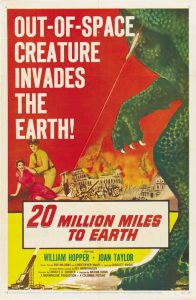I remember seeing Clash of the Titans (1981) in a movie theatre when it was brand new. For those who may not know, this was the last movie to feature Ray Harryhausen’s ground breaking stop motion animation special effects. Ray Harryhausen had done effects for such #NotQuiteClassicCinema classics as The Beast from 20,000 Fathoms (1953), 20 Million Miles to Earth (1957), and, perhaps most famously, Jason and the Argonauts (1963) and the Sinbad movies, beginning with The 7th Voyage of Sinbad (1958) and including my personal favourite Sinbad and the Eye of the Tiger (1977). Harryhausen produced Clash of the Titans, which felt like a continuation of what he’d been doing with Sinbad… and Jason…(bringing mythological creatures to life, etc.) and retired (more or less) shortly thereafter.
By 1981, Harryhausen’s style of special effects were a little old-school next to the likes of the Star Wars movies, but they still had me completely captivated as a kid. Seeing the film again, just a couple of years later, I noticed the difference. But that first viewing was magical. Perhaps the most memorable sequence to me, was the one in which Perseus, our hero, confronts the Gorgon Medusa in her lair. Being a fan of horror movies, even at that young age, I found the portrayal of Medusa, with live snakes for hair, to be delightfully monstrous. Anyone who dared to look directly at her was turned to stone (as evidenced by the collection of stone statues all around her), and that was frightening and exciting all at once. Over the years, i have rarely encountered a cinematic creature more memorable than Medusa.
Over the next two decades, I spent a lot of time in video stores, examining movie boxes and renting as many as seven tapes at a time (thanks to a special deal at Movie Village, my store of choice during and after my university days). I recall seeing the box for The Gorgon (1964) on the shelves, but for some reason I was never moved to rent it. It certainly did not have the effect on me that the box for Vice Squad (1982) had had. I wonder why?
 I had loved Medusa in Clash of the Titans, and I immediately recognized her style of snake-hair on the front of the box. But maybe that was the problem. Maybe I felt like I had already seen the ultimate Medusa movie, and I didn’t need to se this one. Or maybe I felt like it was something that I had liked as a kid, but that I had no real interest in now that I was older. Or maybe I noticed that it was a Hammer Film that didn’t feature vampires or Frankenstein and I didn’t see the point in that. Who knows?
I had loved Medusa in Clash of the Titans, and I immediately recognized her style of snake-hair on the front of the box. But maybe that was the problem. Maybe I felt like I had already seen the ultimate Medusa movie, and I didn’t need to se this one. Or maybe I felt like it was something that I had liked as a kid, but that I had no real interest in now that I was older. Or maybe I noticed that it was a Hammer Film that didn’t feature vampires or Frankenstein and I didn’t see the point in that. Who knows?
Of course, all these years later, the fact that The Gorgon is a Hammer Horror that doesn’t feature vampires or Frankenstein is precisely what makes it interesting to me. And so I watched it, for the first time, last Friday. And the first thing that I must clarify is that it is NOT a Medusa movie after all. It’s about another Gorgon named Megaera. Why? Perhaps because Medusa had been famously killed centuries ago, so how could she be in Europe in relatively modern times turning townspeople to stone?
But wait! It gets weirder. According to Greek mythology, Megaera is not a Gorgon at all. She is an Erinýe, or Fury. There were three of those, just as there were three of the Gorgons. And the Erinýes also had snakes for hair, so perhaps the filmmakers figured six of one, half dozen of the other. Or maybe it was as simple as the name Megaera sounds a bit like Medusa, and is slightly easier to pronounce than Stheno or Euryale, the actual other Gorgons. Who knows?
None of this really matters, because The Gorgon is an entertaining monster movie that has more in common with a classic werewolf story than an ancient Greek epic. I don’t want to say too much about it, because I hate spoilers and I think people should experience movies for themselves to get the full effect. Let’s just say that there have been a series of murders in a small European town in the early 20th century. And the town’s doctor, played by Peter Cushing, is covering up the fact that the victims have all turned to stone. Christopher Lee plays a professor and friend of our young hero, Paul (Richard Pasco), who comes to town to help find out who murdered Paul’s brother and father.
Apparently The Gorgon was the first movie to feature both Peter Cushing and Christopher Lee since The Mummy (1959). If that’s true, this film is certainly proof that a reunion was long overdue. They are both excellent, and their performances make The Gorgon (1964) required viewing for all fans of horror, Hammer Films, and #NotQuiteClassicCinema. Either one of those men, on his own, would be a good reason to spend a #FridayNightAtTheHomeDriveIn. Both of them together make it essential.
 20 Million Miles to Earth (1957) by #NathanJuran
20 Million Miles to Earth (1957) by #NathanJuran
